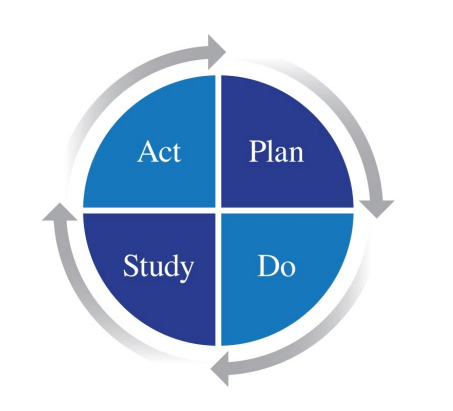Plan Do Study Act (PDSA)





Plan, Do, Study, Act, or PDSA is a 4 stage model used to test and implement system-wide improvement. The PDSA model supports organizations that strive for continuous improvement. Organizations that practice continuous improvement are always searching to improve and want to be consistently more successful than they were in the past. Being more successful depends on identifying areas for better execution and making those improvements. PDSA is a helpful tool in this on-going journey to make each system within an organization function at levels of excellence.
PDSA is a Cycle
During the following video, Jerim DesJarlais, an elementary school principal, provides an example of how PDSA is used in classrooms by teachers and students throughout the school. The application of PDSA cycles may look different in your organization, keep in mind this continuous improvement process can be customized to fit each specific need.
Organizations use data to improve and standardize individual processes and spread those standards for consistent use across the organization. After processes are standardized, consistent, and working well, our focus can turn to improving the entire system. System-wide improvement is a more continuous, long-term project compared to improving one process. A system can be made up of many processes.
The PDSA model is designed to run in cycles which compliments the pressure for continuous change organizations feel today. As results are studied in each PDSA cycle, plans are made for the next round of action. PDSA allows us to test our ideas for improvement work, before we implement them throughout the organization. Rapid cycles of PDSA can lead to faster, more successful system changes. If there are additional changes in the external environment, PDSA cycles allow us to gather results related to those changes, which gives organizations more accurate information for decision-making.

Identify the Problem:
- What are you trying to accomplish?
- How will you know if change is an improvement?
Develop a team to define the problem, look for solutions and develop and communicate the plan. Those who are directly involved and most familiar with the work are ideal for this team. The team should analyze the possible solutions and determine which will be the best to implement. Consider how improvement will be measured and rely on data to inform if the plan of action designed is the best one for the cycle.
Implement the Action Plan
- The change is first tested on a small scale, one step at a time so that any movement in the “wrong” direction can be discovered and mediated quickly.
- As cycles of PSDA are repeated, the change can be tested on a larger scale across multiple levels to determine its effectiveness system-wide.
Study
- Compare the data from the test to the team’s hypothesis.
- Determine if the change is an improvement, or if it created additional problems.
- If something went wrong during the test, it needs to be analyzed to identify the root cause of the problem.
- Document what has been learned from the test and decided if the change should be adapted, adopted, or abandoned.
What Changes Should Be Made?
- Can the solution tested be implemented across a larger group for testing?
- Should the plan be modified and tested again?
Based on the data received, make modifications to the plan and repeat the PDSA cycle. You may even find that completely abandoning the first approach and repeating the cycle is necessary.
These four steps can be repeated as part of an ongoing process of continuous improvement.





